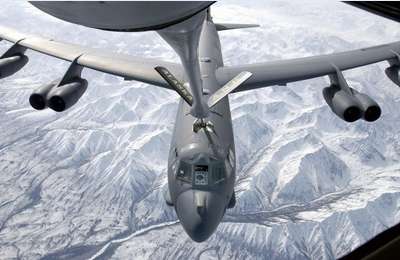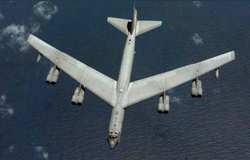Should Fly Into Design's Ninth Decade
The B-52H Avionics Midlife Improvement project recently
completed two missions to test new hardware and software upgrades
in extreme conditions around the world. The missions were part of
the research and developmental test for the project before it moves
to operational test and evaluation, allowing the B-52
Stratofortress to continue flying until 2040.

Officials tested the new hardware and software's ability to
continue navigation without a global positioning
system over the different poles of Earth, the
international dateline and other locations that have different
magnetic readings.
"The purpose of these two sorties was to ensure that the B-52
AMI system is ready to go when the first phase, dedicated
operational test hits this September," said Lt. Col. Shawn Fleming,
Air Force Operational Test and Evaluation Center AMI operational
test director at Edwards AFB (CA).
During DT-1, the first test to the B-52, 419th Flight Test
Squadron officials launched a 16-hour B-52 AMI test mission at 75
degrees north latitude, close to the north pole. The purpose was to
verify proper operation of the equipment where the magnetic
variation from true north and magnetic north is greatest and
conditions are not normal. The flight tested the new systems'
ability to accurately navigate near the north pole while
recognizing the skewed magnetic lines.
"Flying at high latitudes places unique stresses on navigational
systems since the meridians of longitude are much closer together,"
said Fleming. "The purpose of this sortie was to ensure that the
AMI system properly handled flight at these high latitudes."
 The
second mission, called DT-2, was a 22-hour mission over the equator
west of Hawaii. The aircraft was flown to the equator and
international dateline to ensure the AMI navigation system properly
handled multiple crossings of the equator. The mission involved
flying from all different directions with multiple crossings of the
international dateline and equator.
The
second mission, called DT-2, was a 22-hour mission over the equator
west of Hawaii. The aircraft was flown to the equator and
international dateline to ensure the AMI navigation system properly
handled multiple crossings of the equator. The mission involved
flying from all different directions with multiple crossings of the
international dateline and equator.
"These unique cases are challenging for any navigational system
and are very difficult to simulate on the ground," said
Fleming.
With both missions proving the upgrades will work properly, the
developmental tests were considered successful, and the AMI program
is continuing as planned.
The B-52 has been in the Air Force's fleet since 1952. After
three years of test planning, the 412th Test Wing introduced the
B-52's new avionics system into flight December 19. AMI flight
testing is scheduled to continue through December 2004.
While the overall test objective is to evaluate B-52 mission
capabilities, performance and suitability, the AMI program is
specifically designed to upgrade the B-52H Offensive Avionics
System. This upgrade includes replacing the inertial navigation
system, the avionics control unit, the data transfer system and all
associated hardware and software.
"We are moving away from Commodore 64 technology and upgrading
to Pentium III class processors of the late '90s," said Maj.
Merrice Spencer, AMI project navigator and chief of B-52 avionics
and weapons integration. "This will allow the B-52 to operate with
the newest technology, weapons and then some. Without this avionics
upgrade, there is no way weapons coming on line today or in the
future will be able to operate with the B-52 as their
platform."
All Air Force B-52s are scheduled to receive this upgrade by
2007.
[Thanks to Airman 1st Class Wes Auldridge, Air Force Flight Test
Center Public Affairs --ed.]
 Unfortunate... ANN/SportPlane Resource Guide Adds To Cautionary Advisories
Unfortunate... ANN/SportPlane Resource Guide Adds To Cautionary Advisories ANN FAQ: Turn On Post Notifications
ANN FAQ: Turn On Post Notifications ANN's Daily Aero-Term (04.29.24): Visual Approach Slope Indicator (VASI)
ANN's Daily Aero-Term (04.29.24): Visual Approach Slope Indicator (VASI) ANN's Daily Aero-Term (04.28.24): Airport Marking Aids
ANN's Daily Aero-Term (04.28.24): Airport Marking Aids ANN's Daily Aero-Linx (04.28.24)
ANN's Daily Aero-Linx (04.28.24)




